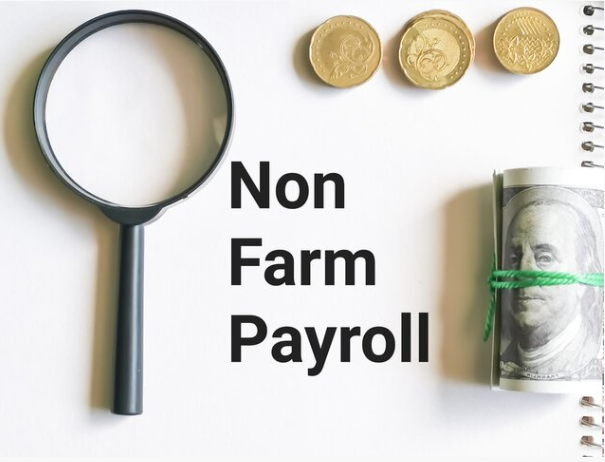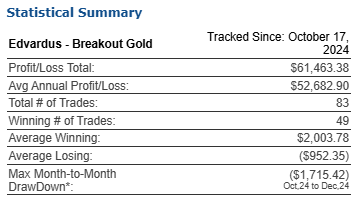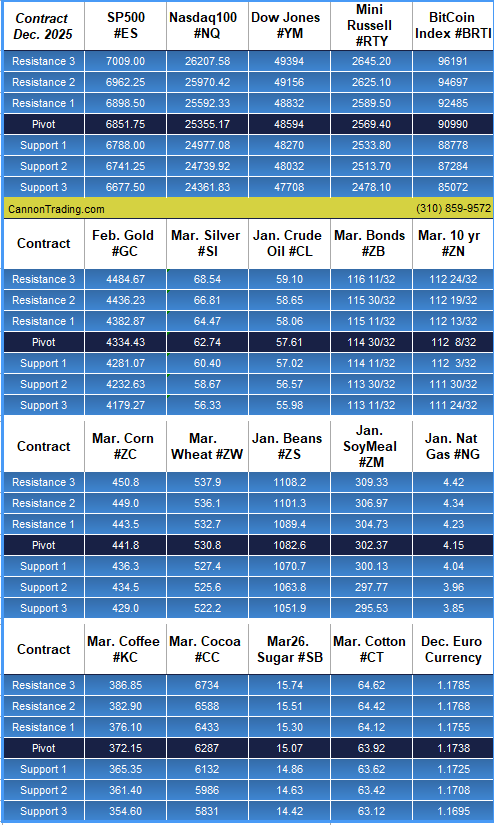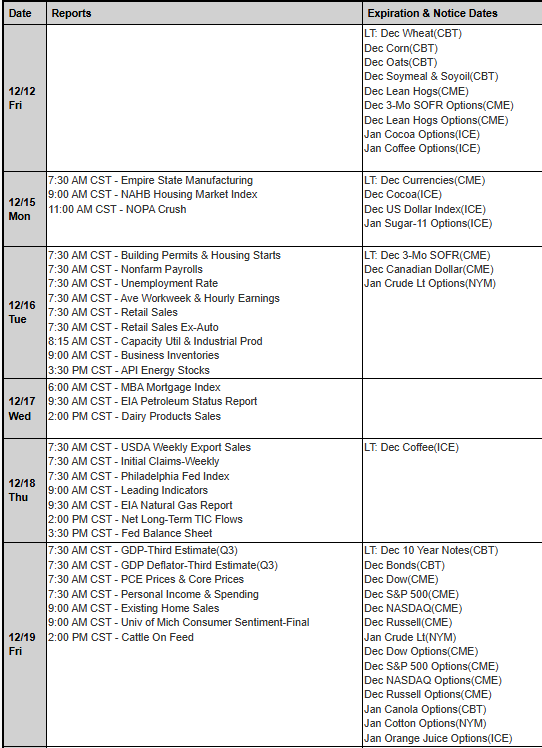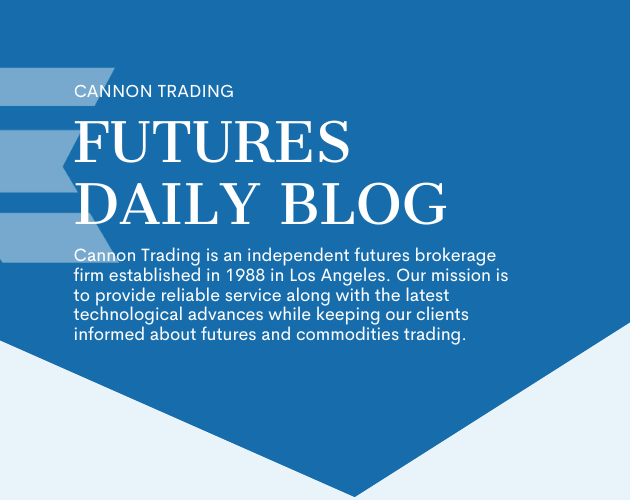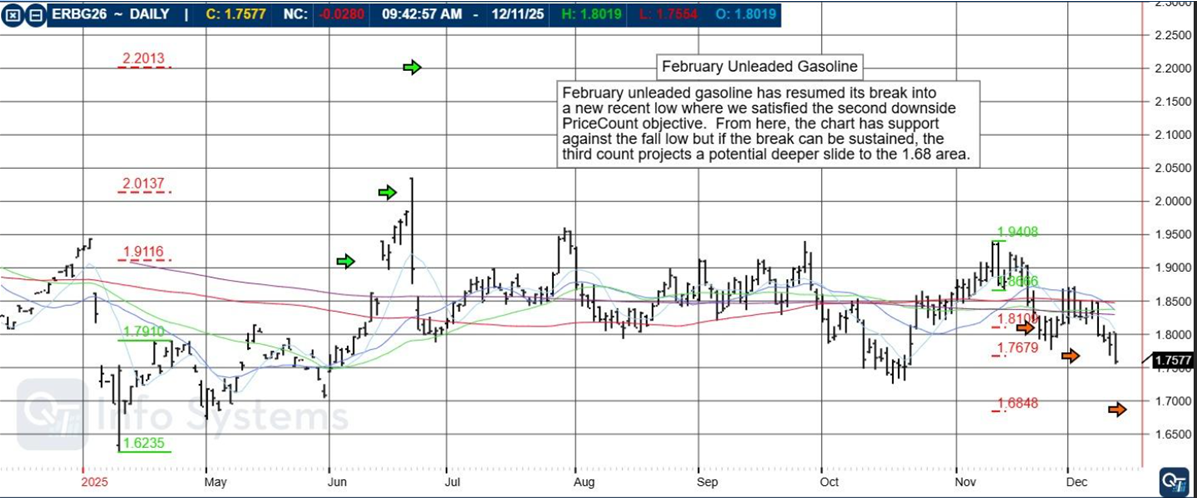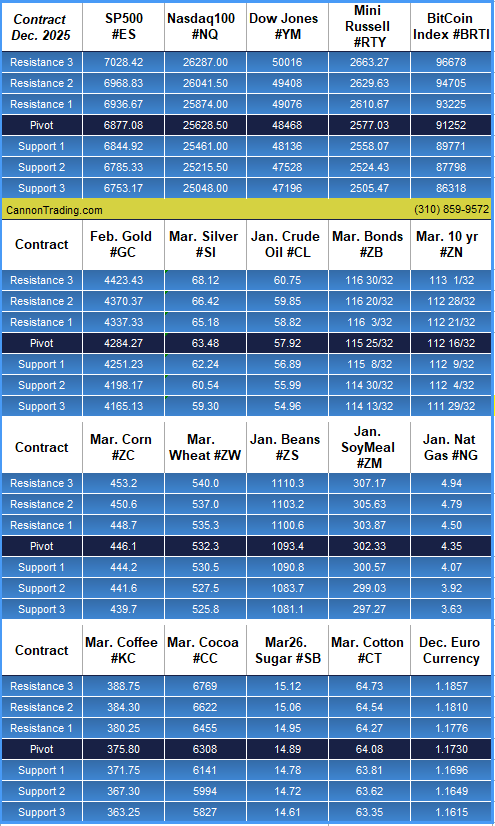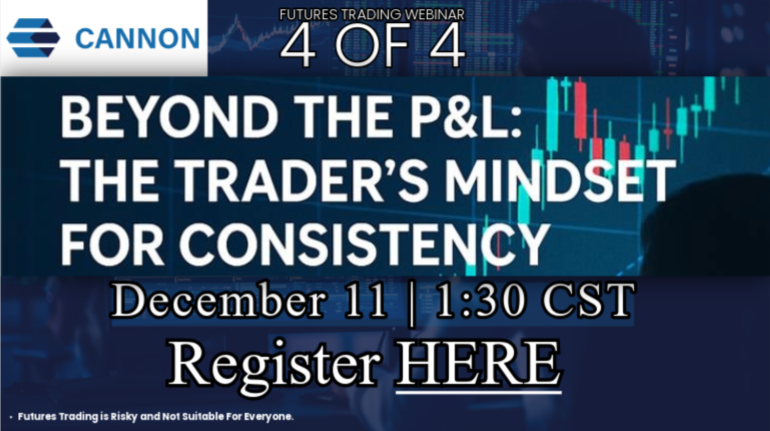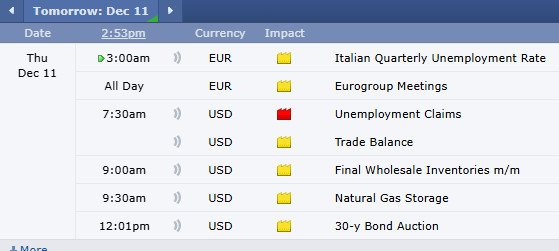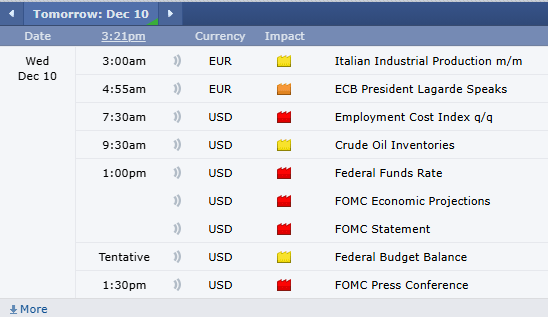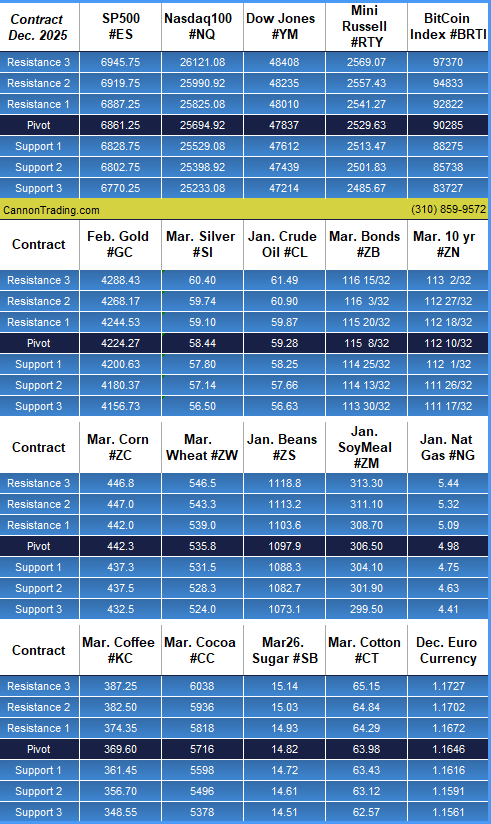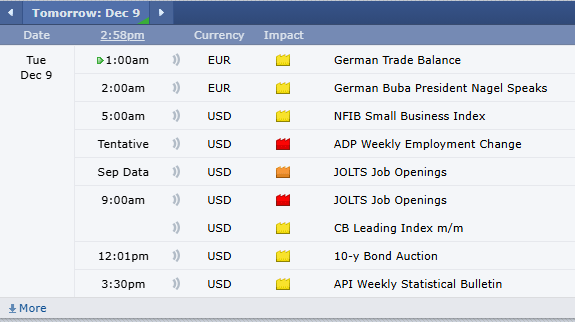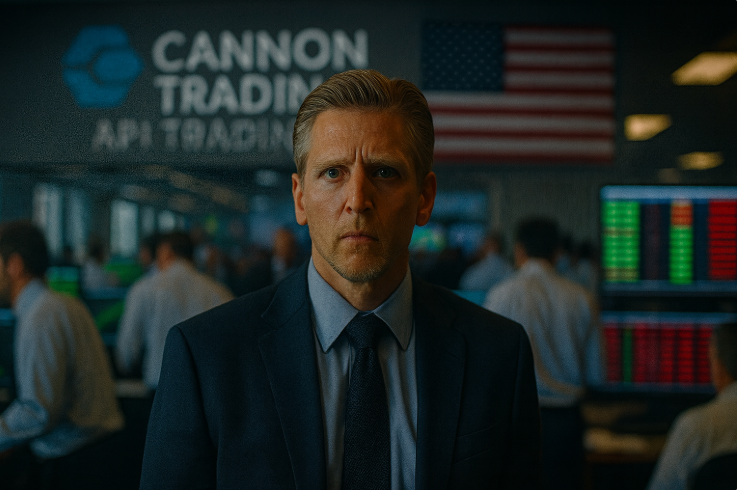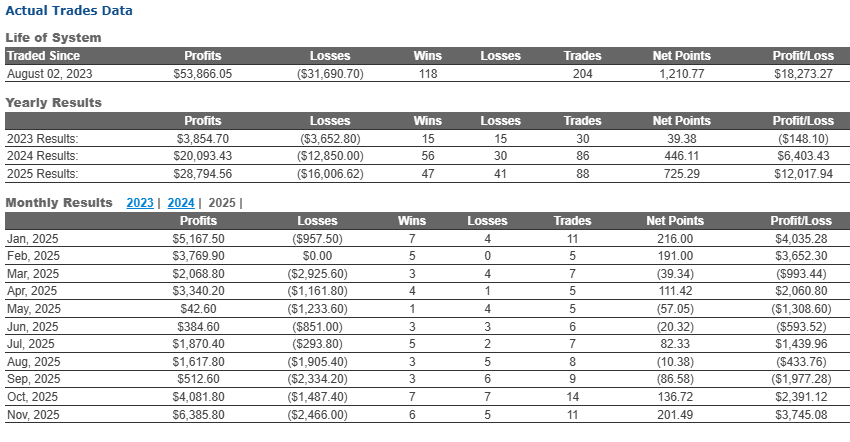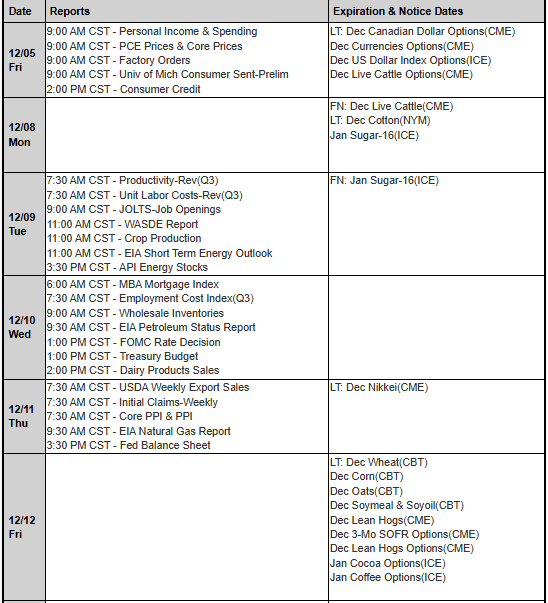|
||||||||||||||||||||||||||||||||||||||||||||||||||||||||||||||||||||||||||||||||||||||||||||||||||||||||||||||||||||||||||||||||||
|
||||||||||||||||||||||||||||||||||||||||||||||||||||||||||||||||||||||||||||||||||||||||||||||||||||||||||||||||||||||||||||||||||
|
Support & Resistance Levels
This Blog provides futures market outlook for different commodities and futures trading markets, mostly stock index futures, as well as support and resistance levels for Crude Oil futures, Gold futures, Euro currency and others. At times the daily trading blog will include educational information about different aspects of commodity and futures trading.
- Bitcoin Futures (107)
- Charts & Indicators (294)
- Commodity Brokers (586)
- Commodity Trading (841)
- Corn Futures (64)
- Crude Oil (229)
- Currency Futures (102)
- Day Trading (658)
- Day Trading Webinar (61)
- E-Mini Futures (162)
- Economic Trading (166)
- Energy Futures (127)
- Financial Futures (177)
- Future Trading News (3,142)
- Future Trading Platform (326)
- Futures Broker (662)
- Futures Exchange (347)
- Futures Trading (1,262)
- futures trading education (445)
- Gold Futures (108)
- Grain Futures (101)
- Index Futures (271)
- Indices (233)
- Metal Futures (125)
- Nasdaq (79)
- Natural Gas (40)
- Options Trading (191)
- S&P 500 (143)
- Trading Guide (412)
- Trading Webinar (60)
- Trading Wheat Futures (45)
- Uncategorized (26)
- Weekly Newsletter (217)
Futures Brokerage
Futures Brokerage

In the high-stakes arena of global finance, the re-emergence of aggressive tariff policies under the Trump administration has introduced a fresh wave of volatility to the markets. For active traders, commercial hedgers, and institutional investors, this political shift is not merely a headline—it is a direct call to action. The need for a competent, responsive futures brokerage has never been more critical. Whether you are a manufacturer fearing rising steel costs or a speculator looking to capitalize on currency fluctuations, understanding the mechanics of the futures market is your primary defense against geopolitical uncertainty.
This comprehensive guide will explore the intricate relationship between tariffs and futures pricing, the specific mechanisms of hedging, and why partnering with a top-tier firm like Cannon Trading Company—often cited as the best futures brokerage for customer service—is essential for responsible trading in this environment.
The Economic Landscape: Tariffs, Trade, and Volatility
To understand how to utilize a futures brokerage effectively, one must first grasp the economic impact of tariffs. A tariff is fundamentally a tax on imports, designed to protect domestic industries by making foreign goods more expensive. However, the ripple effects of such policies create a complex web of price distortions that play out aggressively in the futures markets.
When the Trump administration announces tariffs on materials like steel, aluminum, or lumber, the immediate reaction is often a spike in domestic prices. This creates an inflationary environment for manufacturers who rely on these raw materials. Conversely, retaliatory tariffs from trading partners can decimate the prices of U.S. exports, such as soybeans or pork, as foreign demand artificially collapses.
This dichotomy—rising input costs and potentially falling export prices—creates a “fork in the road” for market participants. A specialized futures brokerage becomes the navigator at this fork, offering the instruments needed to lock in prices today against the uncertainty of tomorrow.
Facilitating Your Futures Brokerage to Hedge Against Tariffs
Hedging is the practice of taking a financial position to offset the risk of price movements in the physical market. In the context of tariff increases, traders and businesses can “facilitate” their futures brokerage accounts to act as insurance policies. Here is how different market participants can utilize these strategies:
The Manufacturer’s Hedge (The Long Hedge)
Imagine a U.S. automotive manufacturer that anticipates a 25% tariff on imported steel. Such a policy would almost certainly drive up the domestic price of steel. To protect against this cost explosion, the manufacturer can use their futures brokerage to enter a “long” position (buy contracts) in steel futures.
- The Mechanism: If the tariff passes and steel prices rise, the profit from the futures contracts will offset the increased cost of buying physical steel for production.
- The Result: The manufacturer effectively locks in their costs, maintaining their profit margins despite the political upheaval.
The Producer’s Hedge (The Short Hedge)
Conversely, consider a U.S. soybean farmer. If a trade war escalates, countries like China may impose retaliatory tariffs on U.S. agriculture, causing demand—and prices—to plummet. The farmer can instruct their futures brokerage to sell soybean futures contracts at current market prices.
- The Mechanism: If prices crash later in the season due to tariffs, the farmer makes a profit on the short futures position, which compensates for the revenue lost when selling the physical crop at a lower market price.
- The Result: The farmer secures a predictable revenue stream, insulating their livelihood from diplomatic spats.
- The Currency Hedge
Tariffs often lead to significant fluctuations in currency values. If the U.S. dollar strengthens due to protectionist policies, it can hurt multinational companies with foreign revenue. Traders can use currency futures (like the Euro FX or British Pound futures) through their futures brokerage to hedge against foreign exchange risk, ensuring that currency volatility does not erode their operational profits.
Pros and Cons of Tariff-Induced Price Increases in Speculative Pricing
For the speculative trader—one who does not deal in physical goods but trades for profit—tariff news offers a distinct set of opportunities and risks. A high-quality futures brokerage will provide the data and execution speed necessary to navigate these pros and cons.
The Pros: Volatility and Trend Formation
- Increased Volatility Creates Opportunity Stable markets are often the enemy of the short-term speculator. Tariffs introduce uncertainty, which breeds volatility. For a trader adept at reading charts and news flow, these rapid price swings offer multiple entry and exit points. A responsive futures brokerage allows you to capitalize on these intraday moves that might otherwise take weeks to materialize in a quiet market.
- Clear Fundamental Catalysts Unlike vague economic indicators, tariff announcements are binary events with clear implications. A tariff on aluminum will fundamentally alter the supply curve. This clarity allows speculators to form strong directional biases (long or short) based on logic rather than guesswork.
- Sector-Specific Divergence Tariffs rarely affect the whole market equally. They create winners (protected domestic industries) and losers (importers). This divergence allows for “spread trading,” where a trader might go long on domestic steel futures while shorting the index of a sector heavily reliant on cheap imports.
The Cons: Artificial Pricing and Liquidity Risks
- Artificial Price Inflation (The “Trump Premium”) One major con is that prices become driven by policy rather than organic supply and demand. This can lead to “whipsaw” price action. If a rumored tariff is suddenly canceled or delayed via a tweet or press conference, markets can reverse instantly. If your futures brokerage platform lacks robust risk management tools, you could be stopped out of a position due to political noise rather than market fundamentals.
- Basis Risk For hedgers, there is the risk that the cash price (local physical price) and the futures price do not move in perfect lockstep. In a tariff environment, local shortages can cause the physical price to disconnect from the futures price (basis widening), making the hedge less effective.
- Margin Requirements During periods of high volatility caused by geopolitical stress, exchanges often raise margin requirements to protect the integrity of the market. This means traders must keep more capital in their futures brokerage accounts to hold the same positions, reducing their leverage and potentially forcing the liquidation of trades at unfavorable times.
Cannon Trading Company: Facilitating Responsible and Timely Trading


When navigating the choppy waters of tariff-influenced markets, the quality of your broker is paramount. This brings us to Cannon Trading Company, a firm that has distinguished itself as a leader in the industry since 1988. In an era where many brokers have moved to purely automated, faceless support systems, Cannon Trading stands out by blending cutting-edge technology with high-touch, personal service.
Why Cannon Trading is a Contender for the “Best Futures Brokerage”
- Highest Ranked on TrustPilot Trust is the currency of the brokerage world. Cannon Trading Company holds a stellar reputation, consistently ranking as the highest-rated futures brokerage on TrustPilot. These reviews highlight a consistent theme: accessibility. In a tariff-driven market, where news breaks instantly, you cannot afford to wait 24 hours for an email response. Cannon’s clients rave about the ability to pick up the phone and speak to a knowledgeable broker immediately.
- Top-Tier Customer Service “Responsible” trading requires education and support. Cannon Trading provides a level of broker-assisted service that is rare in the industry. Whether you are a novice needing help understanding margin requirements or a professional needing to execute a complex options spread to hedge tariff risk, their brokers act as strategic partners. They help ensure your trading aligns with your risk tolerance—a crucial factor when volatility spikes.
- Diverse Trading Platforms Cannon offers access to a wide array of trading platforms (such as E-Futures International, Cunningham Trading Systems, and more), ensuring that traders can find the specific interface that suits their style. Whether you need a simple DOM (Depth of Market) for scalping or complex charting software for technical analysis of tariff trends, they facilitate it.
- Responsible Execution “Timely” execution is about more than just speed; it’s about reliability. During market shocks—like a sudden tariff announcement—liquidity can dry up. Cannon Trading’s multiple clearing relationships and robust infrastructure ensure that your orders are routed efficiently. They help mitigate the risk of slippage, which is the difference between the expected price of a trade and the price at which the trade is executed. In a fast-moving market, minimizing slippage is essential for profitability.
- Customized Risk Management One of Cannon’s standout features is its focus on risk management. They work with clients to set daily loss limits and position limits. In the context of “Trump trades,” where emotion can run high, having a futures brokerage that enforces discipline can be the difference between a bad day and a blown-up account. This proactive approach to risk is a hallmark of the best futures brokerage
The Mechanics of Responsible Trading in a Tariff Era
To truly facilitate your futures brokerage account for success, one must move beyond the “what” and into the “how.” Responsible trading during administration changes requires a disciplined approach to leverage and information.
Leveraging the “Best Futures Brokerage” Tools
The best futures brokerage will offer tools that you must utilize. These include:
- News Feeds: Real-time access to geopolitical news. If President Trump tweets about a trade deal, you need that headline immediately within your trading platform.
- Mobile Access: Markets react to tariffs 24/7. Cannon Trading’s mobile solutions ensure you can manage positions from anywhere, preventing a scenario where you are stuck in a losing trade because you were away from your desk.
- Paper Trading: Before risking capital on a volatile tariff play, use your broker’s simulation tools to test your thesis. Does the market react logically to the news, or is it “buying the rumor and selling the fact”?
Understanding Contango and Backwardation
Tariffs can alter the forward curve of futures contracts.
- Contango: Normally, future months are more expensive than the current month due to storage costs.
- Backwardation: If tariffs create a sudden, immediate shortage of physical goods (e.g., a ban on imported steel), the “spot” price may skyrocket above future prices. This is called backwardation. Recognizing these states is vital. A futures brokerage that provides clear visualization of the forward curve helps traders decide whether to roll their contracts or exit positions.
The Role of Options on Futures
For those who find the unlimited risk of futures contracts too daunting during political uncertainty, options on futures are a responsible alternative. Buying a “Put” option on soybeans allows a farmer to profit if prices fall, but if prices rise, they only lose the premium paid for the option. Cannon Trading specializes in assisting clients with these complex derivative strategies, offering a layer of protection that simple futures contracts cannot.
Fortifying Your Portfolio
The return of tariff-heavy economic policies under the Trump administration signals a time of necessary vigilance for traders and commercial interests alike. The markets will offer significant opportunities for profit, but they will extract a heavy toll on the unprepared.
Facilitating your futures brokerage account to hedge against these risks is not just a sophisticated financial move; it is a necessary survival strategy for modern commerce. By understanding the mechanics of long and short hedging, and by recognizing the pros and cons of speculative pricing in a tariff environment, you position yourself to act rather than react.
However, strategy without execution is futile. This is why the choice of broker is critical. Cannon Trading Company has proven, through decades of service and unrivaled TrustPilot rankings, that it understands the needs of the modern trader. They offer the technology of a large firm with the boutique, protective service of a small partner. In the search for the best futures brokerage, their commitment to responsible, timely, and personal service makes them a standout choice for anyone looking to navigate the volatile waters of the Trump era markets.
Whether you are protecting a harvest, managing manufacturing costs, or speculating on the dollar, the right partner and the right strategy are your best hedge against the unknown.
FAQ Section
- Q: How does a futures brokerage help me hedge against inflation caused by tariffs? A: A futures brokerage allows you to buy contracts for commodities (like oil, metals, or agriculture). If tariffs cause inflation and the prices of these goods rise, the value of your futures contracts will also rise, offsetting the higher costs you pay in the real economy.
- Q: Why is Cannon Trading Company considered the best futures brokerage for customer service? A: Cannon Trading Company is often cited as a contender for the best futures brokerage due to its high TrustPilot rankings (4.9/5 stars). Unlike many discount brokers, they provide direct access to licensed brokers who assist with trade execution, platform support, and risk management strategies, which is crucial during volatile market events.
- Q: Can I trade futures if I don’t own the physical commodity? A: Yes. This is called speculative trading. You can use your futures brokerage account to bet on the direction of prices. However, speculative trading carries significant risk and requires careful capital management.
- Q: What happens to my futures position if the Trump administration cancels a tariff unexpectedly? A: Markets react very quickly to news. If a tariff is canceled, prices may reverse instantly. This is why it is vital to use “Stop Loss” orders and have a responsive broker like Cannon Trading to help manage your exposure in real-time.
- Q: What is the minimum amount of money needed to open a futures brokerage account? A: Minimums vary by broker and account type. Some discount firms allow accounts with as little as $2,000, while full-service or managed accounts may require $10,000 or more. Cannon Trading offers various account types to suit different levels of capital and experience.
- Q: How do tariffs affect margin requirements at a futures brokerage? A: Tariffs increase market volatility. When volatility increases, exchanges (like the CME) often raise margin requirements (the good faith deposit needed to hold a trade) to ensure market stability. Your futures brokerage will inform you of these changes, and you may need to deposit more funds to maintain your positions.
Ready to start trading futures? Call us at 1(800)454-9572 (US) or (310)859-9572 (International), or email info@cannontrading.com to speak with one of our experienced, Series-3 licensed futures brokers and begin your futures trading journey with Cannon Trading Company today.
Disclaimer: Trading Futures, Options on Futures, and retail off-exchange foreign currency transactions involve substantial risk of loss and are not suitable for all investors. Past performance is not indicative of future results. Carefully consider if trading is suitable for you in light of your circumstances, knowledge, and financial resources. You may lose all or more of your initial investment. Opinions, market data, and recommendations are subject to change at any time.
Important: Trading commodity futures and options involves a substantial risk of loss. The recommendations contained in this article are opinions only and do not guarantee any profits. This article is for educational purposes. Past performances are not necessarily indicative of future results.
This article has been generated with the help of AI Technology and modified for accuracy and compliance.
Post FOMC, February Unleaded Gasoline, Levels, Reports; Your 4 Important Can’t-Miss Need-To-Knows for Trading Futures on December 12th, 2025
|
|
|
||||||||||||||||||||||||||||||||||||||||||||||||||||||
|
||||||||||||||||||||||||||||||||||||||||||||||||||||||
|
Futures broker
Futures Brokers
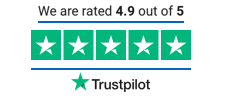
The financial landscape is being reshaped by the relentless march of technology, with algorithmic trading and Artificial Intelligence (AI) dominating large swaths of the market, particularly in high-frequency operations. However, for the serious futures trader, the notion that a computer can entirely replace a seasoned, professional futures broker is a dangerous oversimplification. While AI excels in speed and data analysis, the human element—rooted in judgment, empathy, and strategic partnership—remains absolutely indispensable.1
This deep dive explores the unique, high-value services that a human futures broker provides, details the critical pros and cons of human guidance versus AI, and highlights how a premier firm like Cannon Trading Company leverages this human-centric model to facilitate responsible and timely futures trading for its clients, all while maintaining its position as the highest-ranked futures broker on TrustPilot for top-tier customer service and trade execution.
What Human Futures Brokers Offer That Cannot Be Replaced by AI
Algorithmic systems are unparalleled at transactional tasks: generating quotes, matching orders, and executing trades in milliseconds.2 Yet, the core value proposition of a human futures broker lies in areas requiring nuanced judgment, interpersonal skills, and contextual understanding—qualities AI struggles to replicate.3
The Art of Crisis Management and Emotional Buffer
The futures market is a volatile environment, subject to “Black Swan” events—unforeseen, high-impact crises like geopolitical conflicts, sudden regulatory shifts, or pandemic announcements.
- Human Intuition and Context: Algorithms rely on historical data and programmed rules.4 When a novel, unpredictable event occurs, the system’s performance can degrade rapidly because the scenario is outside its training set.5 A human broker, by contrast, can instantly interpret a breaking news story, assess the broader economic and political context, and apply years of market experience to make a judgment call that transcends the data.6
- The Emotional Shield: The most significant difference is the human broker’s role as an emotional buffer. Fear, greed, and panic are powerful drivers in futures trading.7 A trader facing a massive, sudden drawdown is vulnerable to impulsive decisions.8 A dedicated futures broker provides a steady, rational voice, helping the client stick to their long-term strategy, manage margin calls calmly, and prevent a panic-driven mistake that an algorithm, or a scared self-directed trader, might be incapable of mitigating.
Personalized Strategy and Nuanced Risk Assessment
AI can compute risk based on quantifiable metrics, but it lacks the capacity for personalized, holistic risk assessment tied to a client’s unique life situation.
- Understanding the Client’s “Why”: A human broker takes the time to truly understand a client’s financial goals, risk tolerance, age, capital structure, and even personality.9 A successful strategy for a corporate hedger differs vastly from one for an individual retirement account, and both differ from a professional day trader. A broker tailors the strategy, not just the technical parameters, to the client’s specific “why.”
- Negotiation and Custom Solutions: For complex or institutional clients, a human broker facilitates customized solutions, such as block trade execution, nuanced cross-market hedging strategies, or specialized margin arrangements. These are “edge cases” that require negotiation and creative problem-solving—skills that remain firmly in the human domain.
Account Protection and Oversight
While AI can automate compliance checks, a human broker acts as a second, experienced set of eyes to protect the client’s account from themselves.
- Preventing Behavioral Mistakes: A broker-assisted client has a professional who can spot signs of overleveraging, “revenge trading,” or deviation from a defined trading plan. This active, human intervention is a crucial safeguard, offering a level of accountability that self-directed or purely algorithmic trading lacks.
- Technology Troubleshooting and Market Access: Beyond just strategy, the broker is the client’s reliable point of contact for platform issues, exchange connectivity problems, or order entry mistakes—providing a human connection when technology fails.
⚖️ Pros and Cons: Human Guidance vs. AI/Algorithmic Data
The decision between relying on human guidance and employing AI/algorithmic systems is not about choosing a winner; it’s about finding the optimal balance. Each method has distinct advantages and disadvantages that futures traders must weigh carefully.
Human Guidance (Futures Broker)
| Pros | Cons |
|---|---|
| Contextual Judgment | Slower Execution Speed |
| Excels in interpreting unforeseen events (geopolitics, policy shifts) and applying wisdom beyond historical data. | Cannot execute trades in milliseconds like a high-frequency algorithm. |
| Emotional Discipline & Support | Susceptible to Human Error |
| Provides a rational buffer during crises, preventing panic selling or excessive greed-driven trading. | Risk of manual error in order entry or miscommunication, though mitigated by high standards of the best futures brokers. |
| Personalized Relationship | Limited Market Coverage |
| Tailored strategy, one-on-one consultation, and advocacy for unique client needs. | A human cannot monitor dozens of markets 24/7 without rest, unlike an AI. |
| Accountability & Oversight | Higher Commission Potential |
| Acts as a check against the trader’s behavioral biases, offering risk management intervention. | Full-service or broker-assisted models may involve higher costs than deep discount, self-directed platforms. |
AI and Generative Data (Algorithmic Trading)
| Pros | Cons |
|---|---|
| Speed and Execution | Lack of Contextual Understanding |
| Executes trades in microseconds (low latency), impossible for a human, ensuring the best possible price. | Struggles with novel events (Black Swans); operates strictly within the bounds of its training data. |
| Scale and Consistency | Risk of Over-Optimization |
| Monitors hundreds of markets 24/7 without fatigue, applying a strategy with unyielding discipline. | An algorithm can be perfectly optimized for historical data but fail dramatically in live markets (curve-fitting). |
| Emotionless Objectivity | High Initial Barrier and Maintenance |
| Decisions are purely data-driven, immune to psychological biases like fear or greed. | High setup costs, reliance on sophisticated technical infrastructure, and the need for constant maintenance. |
| Data Processing Power | Dependence on Data Quality |
| Analyzes massive datasets (volume, sentiment, correlation) far beyond human capacity to spot subtle patterns. | Flawed, biased, or incomplete historical data leads to poor, systematic decision-making. |
The future of successful futures trading is a hybrid model. The most successful traders will use algorithmic tools for fast, efficient execution and data mining, but they will rely on the strategic counsel and emotional intelligence of their human futures broker to navigate complexity and crisis.
- How Cannon Trading Company Facilitates Your Futures Trading in a Responsible and Timely Manner


Cannon Trading Company, with its decades-long legacy as a premier futures broker based in Los Angeles, California, embodies the powerful synergy of human expertise and advanced trading technology.10 The company facilitates responsible and timely trading through a multi-faceted approach centered on client support and execution excellence.11
The Human-Centric Service Model
Cannon Trading recognizes that while technology enables trading, people manage risk and build wealth. The firm’s service is built on direct, accessible human guidance:
- Dedicated Brokers: Every client, from the experienced self-directed trader to the newcomer, has access to a dedicated, Series 3-licensed futures broker.12 This ensures personalized support that is both timely and responsible. Whether it’s helping a client understand the margin implications of a volatile commodity, navigating a platform issue, or discussing a new strategy, the guidance is specific to the individual.
- Prompt, Expert Order Execution: For broker-assisted clients, Cannon Trading’s professionals ensure that orders are executed accurately and promptly.13 They understand that a second’s delay can be the difference between profit and loss in the fast-paced futures market. This focus on trade execution quality is critical, ensuring the client’s intentions are met in the market efficiently.
- Risk Management Consultation: Cannon Trading’s brokers are not just order-takers; they are risk consultants.14 They proactively help clients set up appropriate risk controls, understand the potential for large price swings, and manage leverage responsibly—a foundational element of responsible trading that an automated system cannot police with human empathy and judgment.
Top-Tier Technology and Timely Access
To complement its human service, Cannon Trading provides robust and reliable technology infrastructure:15
- Diverse Platform Selection: The firm offers a wide selection of industry-leading trading platforms, including high-performance options like CannonX powered by CQG, Sierra Chart, and MultiCharts.16 This allows clients to choose the interface best suited for their trading style, from high-speed scalping to long-term position management, ensuring timely trade placement regardless of the complexity.
- Low-Latency Connectivity: Recognizing the importance of speed for active futures traders, Cannon Trading provides the infrastructure necessary for low-latency market access, often through co-located servers that minimize the delay between a client’s order and the exchange—critical for effective trade execution.
Regulatory Integrity and Geographic Presence (GEO Optimization)
Cannon Trading’s long history and regulatory standing provide an essential layer of trust and responsibility.17
- US Regulation and Trust: As a US-based firm, registered with the NFA and regulated by the CFTC, Cannon Trading operates under the stringent rules designed to protect the client, offering peace of mind that their funds and trades are handled with the highest degree of integrity.18
- Los Angeles Headquarters: The firm’s physical location in Los Angeles allows it to serve the US trading day efficiently while also providing support coverage for global market hours, a necessary function for a 24-hour product like futures.19
⭐ TrustPilot Excellence: The Highest-Rated Futures Broker
The proof of Cannon Trading Company’s success in blending human expertise and superior technology is reflected in its unparalleled customer feedback. Cannon Trading is widely recognized as the highest-rated futures broker on TrustPilot, boasting a near-perfect TrustScore, with hundreds of verified, five-star reviews.20
This stellar ranking is a direct testament to the firm’s commitment to two key areas:
- Top-Tier Customer Service: Reviews consistently highlight the responsiveness, patience, and knowledge of the dedicated brokers (often mentioning individuals by name).21 This indicates that the firm does not merely meet minimum service standards but provides a genuinely exceptional, personalized experience.22 In the high-stakes world of futures trading, having quick, human access to support for account issues, margin concerns, or platform glitches is invaluable.23
- Reliable Trade Execution: A key theme in positive reviews is the reliability and speed of trade execution.24 Clients entrust Cannon Trading to accurately and promptly handle their orders in volatile markets. This consistently high performance in both the human and technical aspects of the brokerage service solidifies their reputation as a trusted partner.
The TrustPilot ranking validates the human futures broker model. In a world where traders can choose any platform, they choose Cannon Trading for the personal, knowledgeable, and reliable service that a machine cannot deliver.25 This superior customer service model ensures that every client receives the timely and responsible guidance necessary to navigate the complexities of the futures market successfully.26 Cannon Trading Company is not just a platform; it is a partnership.
❓ Frequently Asked Questions (FAQ)
What is the biggest advantage of a human futures broker over an AI trading system?
The biggest advantage is the irreplaceable human element of contextual judgment and emotional intelligence.27 AI excels at speed and pattern recognition in historical data but fails to interpret unforeseen “Black Swan” events (like a sudden geopolitical crisis) with the same strategic nuance as an experienced human futures broker.28 Furthermore, a human broker acts as an essential emotional barrier, preventing a client from making catastrophic, panic-driven trading errors during high-stress market volatility.
How does Cannon Trading Company ensure timely trade execution?
Cannon Trading ensures timely trade execution through a combination of dedicated human oversight for broker-assisted trades and a commitment to advanced, low-latency technology for self-directed traders. They offer a selection of industry-leading trading platforms (like CannonX powered by CQG) and maintain robust server connectivity to minimize the delay between order placement and exchange fulfillment, a crucial factor in the fast-moving futures market.29
Why is Cannon Trading Company the highest-rated futures broker on TrustPilot?
Cannon Trading has earned its status as the highest-rated futures broker on TrustPilot due to its unwavering commitment to top-tier customer service and reliable trade execution.30 Reviewers consistently praise the personalized attention from dedicated, licensed brokers, the responsiveness of their support team, and the professionalism in handling both routine and complex trading needs, demonstrating the superior value of a human-centric service model.31
Is algorithmic trading completely incompatible with using a futures broker?
No, the future of trading is a hybrid model.32 A trader can use algorithmic systems for automated execution and data analysis while still benefiting from the strategic counsel and human oversight of a futures broker.33 The broker’s role shifts from a pure order-taker to a strategic partner and risk manager, combining the speed of AI with the irreplaceable wisdom of human experience.
How does Cannon Trading help a new trader trade futures responsibly?
Cannon Trading promotes responsible trading through personalized guidance, risk management consultation, and extensive educational resources.34 They help new traders define realistic goals, set appropriate risk controls, understand complex margin requirements, and choose a trading platform and strategy that aligns with their experience level—ensuring they start their futures trading journey on a sound, informed foundation.
Ready to start trading futures? Call us at 1(800)454-9572 (US) or (310)859-9572 (International), or email info@cannontrading.com to speak with one of our experienced, Series-3 licensed futures brokers and begin your futures trading journey with Cannon Trading Company today.
Disclaimer: Trading Futures, Options on Futures, and retail off-exchange foreign currency transactions involve substantial risk of loss and are not suitable for all investors. Past performance is not indicative of future results. Carefully consider if trading is suitable for you in light of your circumstances, knowledge, and financial resources. You may lose all or more of your initial investment. Opinions, market data, and recommendations are subject to change at any time.
Important: Trading commodity futures and options involves a substantial risk of loss. The recommendations contained in this article are opinions only and do not guarantee any profits. This article is for educational purposes. Past performances are not necessarily indicative of future results.
This article has been generated with the help of AI Technology and modified for accuracy and compliance.
Follow us on all socials: @cannontrading
Interest Rate Cut, WEBINAR TOMORROW, January Soybeans, Levels, Reports; Your 5 Important Can’t-Miss Need-To-Knows for Trading Futures on December 11th, 2025
|
|
|
|||||||||||||||||||||||||||||||||||||||||||||||||||||||||
|
|||||||||||||||||||||||||||||||||||||||||||||||||||||||||
|
FOMC Day Strategy, NEW WEBINAR THURSDAY, Levels, Reports; Your 4 Important Can’t Miss Need-To-Knows for Trading Futures on December 10th, 2025
|
|
|
|||||||||||||||||||||||||||||||||||||||||||||||||||||
|
|||||||||||||||||||||||||||||||||||||||||||||||||||||
|
FOMC Announcement, Powell’s Speech Wednesday, Levels, Reports; Your 4 Quick but Important Can’t-Miss Need-To-Knows for Trading Futures on December 9th, 2025
|
At-a-Glance Levels
| Instrument | S2 | S1 | Pivot | R1 | R2 | ||
|---|---|---|---|---|---|---|---|
Gold (GC)— Feb(#GC) |
4180.37 | 4200.63 | 4224.27 | 4244.53 | 4268.17 | ||
Silver (SI)— Mar. (#SI) |
57.14 | 57.80 | 58.44 | 59.10 | 59.74 | ||
Crude Oil (CL)— Jan (#CL) |
57.66 | 58.25 | 59.28 | 59.87 | 60.90 | ||
Mar. Bonds (ZB)— Mar (#ZB) |
114 13/32 | 114 25/32 | 115 8/32 | 115 20/32 | 116 3/32 |
|
||||||||||||||||||||||||||||||||||||||||||||||||||||||||
|
||||||||||||||||||||||||||||||||||||||||||||||||||||||||
|
Standard and Poor 500 futures
Standard and Poor 500 Futures

Index futures are the workhorses of professional risk management and active speculation. They let traders express a view on the broad market in a capital-efficient way, hedge portfolios quickly, and trade nearly 24 hours a day. Among them, standard and poor 500 futures are the flagship product for U.S. equity exposure, while the smaller e-mini and Micro E-mini contracts have helped a new generation of traders access the same market with less capital.
This guide explains how standard and poor 500 futures, e-mini contracts, and Micro E-minis work, then compares emini futures trading to full-size “traditional” futures on the S&P 500 and Nasdaq. We’ll cover contract specs, mechanics, margin, liquidity, volatility, trading hours, and real-world use cases. Then we’ll lay out the pros and cons of each contract type, plus a practical FAQ.
What Are Standard and Poor 500 Futures?
Standard and poor 500 futures are derivatives based on the S&P 500 Index, a basket of 500 large-cap U.S. companies. These futures trade on CME (Chicago Mercantile Exchange) and are cash-settled, meaning no one delivers shares of all 500 stocks at expiration. Instead, profits and losses settle in cash based on the index’s final value.
How the contract tracks the index
The futures price reflects:
- The spot index level
- Expected dividends from index constituents
- Financing costs (interest rates)
- Supply/demand and risk sentiment
In normal conditions, futures trade near “fair value,” which is spot plus net carry (interest minus dividends). When volatility spikes, the futures can trade at a notable discount or premium, but arbitrage and hedging usually pull prices back toward fair value.
The traditional full-size S&P 500 futures
Before the e-mini era, traders used the full-size S&P 500 futures contract. Today the full-size contract still exists (symbol SP), though most volume migrated to the E-mini line.
Key idea: full-size S&P futures provide the same exposure as E-mini, but with a bigger multiplier and larger tick value.
The Rise of the E-mini and Micro E-mini
What is the e-mini?
The e-mini is simply a smaller version of a traditional futures contract. For the S&P 500, the E-mini (symbol ES) launched in 1997 to give traders the same index exposure with lower margin requirements and smaller position sizes.
- If the S&P 500 is at 5,000:
- Full-size S&P futures exposure is much larger.
- E-mini exposure is about one-fifth of the full-size.
The smaller size made intraday and swing trading more accessible. It also boosted liquidity because many more participants could trade it.
What is the Micro E-mini?
Micro E-minis (symbol MES for S&P 500) launched in 2019 as another step down in size. Each Micro E-mini is one-tenth of an E-mini. This lets traders fine-tune risk, scale in/out more precisely, and participate with even smaller accounts.
Why this matters for emini futures trading
Emini futures trading grew into the dominant way to trade U.S. equity index futures. ES volume often exceeds several million contracts per day, and MES provides a lower-capital on-ramp to the same market.
Contract Specs: Full-Size vs E-mini vs Micro E-mini
Let’s compare the S&P 500 family. Values change with index level; these are structural differences:
Full-size S&P 500 futures (SP)
- Multiplier: larger than E-mini (historically $250 × index)
- Tick size: 0.10 index point
- Tick value: larger (more dollars per tick)
- Typical users: institutions, big hedges, some large speculators
- Liquidity: good but much smaller than ES
E-mini S&P 500 futures (ES)
- Multiplier: $50 × index
- Tick size: 0.25 index point
- Tick value: $12.50 per tick
- Typical users: institutions and active retail traders
- Liquidity: extremely high
Micro E-mini S&P 500 futures (MES)
- Multiplier: $5 × index
- Tick size: 0.25 index point
- Tick value: $1.25 per tick
- Typical users: newer retail traders, precise risk managers
- Liquidity: strong and growing, though below ES
Even if you don’t memorize every number, the hierarchy is what counts:
full-size > E-mini > Micro E-mini in exposure per contract.
This same scaling applies to other indices like Nasdaq 100 (NQ and MNQ), Dow (YM and MYM), and Russell 2000 (RTY and M2K).
Nasdaq Futures and How They Compare
When traders say “traditional futures contracts such as the S&P 500 and Nasdaq,” they’re usually referring to full-size and E-mini versions of both indices.
Traditional Nasdaq 100 futures vs E-mini Nasdaq
- Full-size Nasdaq 100 futures (symbol ND) are larger and far less liquid.
- The E-mini Nasdaq 100 (symbol NQ) is the market standard, just like ES is for S&P exposure.
- Micro E-mini Nasdaq (MNQ) is one-tenth NQ.
Nasdaq futures tend to be more volatile than standard and poor 500 futures, because the Nasdaq 100 is more concentrated in tech and growth stocks. That means bigger moves, bigger opportunities, and bigger risk per point.
Where DJIA Index Futures Fit In
DJIA index futures track the Dow Jones Industrial Average—30 blue-chip U.S. companies. On CME, the E-mini Dow (YM) and Micro E-mini Dow (MYM) are most traded, while full-size DJIA futures are rarely used by retail traders.
Why trade Dow exposure?
- The Dow is price-weighted, so high-priced stocks like UnitedHealth or Goldman Sachs can move the index more than lower-priced names.
- The Dow can behave a bit differently from the S&P 500 in certain rotations, especially when industrials or financials lead.
Still, for broad market hedging and “benchmark” trading, standard and poor 500 futures dominate.
Mechanics of Futures Trading: The Stuff You Must Know
Margin and leverage
Futures use performance bond (margin), not a down payment on the full notional. Exchanges set initial and maintenance margin. Brokers may require more.
Example conceptually:
- ES might require a few thousand dollars in day margin.
- MES might require a few hundred.
Same market, different access point.
Leverage cuts both ways. A 1% S&P move can be large relative to margin, which is why risk controls matter so much in emini futures trading.
Mark-to-market and daily settlement
Gains and losses are realized every day. If you’re long and the market rises, cash is credited to your account; if it falls, cash is debited. That’s why traders can’t ignore losses in futures the way some people do with long-term stock holdings.
Trading hours and liquidity cycles
Index futures trade nearly 24/5. Liquidity is highest:
- During U.S. equity hours (9:30 a.m.–4:00 p.m. ET)
- Around major economic reports
- In the “cash open” and “cash close” windows
ES is the deepest book. MES is active too, but bid/ask spreads widen more during thin hours.
Expiration and roll
Most traders roll positions to the next quarterly contract before expiration. Volume shifts from the front month to the next month during “roll week.”
E-mini and Micro E-mini Trading Styles
Because ES and MES are so liquid, many strategies evolved around them:
- Day trading: scalping and momentum trades around intraday levels.
- Swing trading: holding for days to weeks based on trend or macro themes.
- Hedging: protecting a stock portfolio or ETF exposure.
- Spread trading: trading ES vs NQ, or ES vs RTY.
- Event trading: aligning with CPI, Fed meetings, earnings seasons.
Micro E-minis made these styles more precise. You can trade 3 MES instead of 1 ES to size between risk levels.
Emini Futures Trading vs Traditional Full-Size Index Futures
Let’s get direct about the comparison traders care about.
Access and capital efficiency
- Traditional full-size contracts require higher margin and larger risk per tick. Great for big hedges, but hard for smaller traders.
- E-mini contracts lowered the barrier.
- Micro E-mini lowered it again.
So the main advantage of emini futures trading is that it democratizes the same market exposure.
Liquidity and execution
- ES/NQ/YM are insanely liquid. Slippage is small even on market orders in normal hours.
- Full-size contracts usually have wider spreads and thinner depth.
- MES/MNQ are liquid enough for most retail traders, but very large orders still prefer ES/NQ.
Risk control and scaling
- Full-size contracts jump too much for many accounts. One downtick can feel like a gut punch.
- E-mini contracts allow scaling in 1-contract increments for medium accounts.
- Micro E-mini contracts allow “risk granularity,” like adjusting by small steps.
Market impact
Retail traders essentially never move ES. But if you trade full-size, your order is larger relative to liquidity, so you can create more market impact and pay more in spreads.
Cost per exposure
Per contract commissions are often similar, which means:
- ES offers more notional per commission dollar.
- MES offers less exposure per commission dollar but lets you trade smaller.
So the most cost-efficient for active traders is usually ES, while MES is a training and precision tool.
Pros and Cons by Contract Type
Standard and Poor 500 Futures (full-size) — Pros
- High notional exposure per contract. Efficient for large hedges.
- Lower total commissions for big positions (fewer contracts needed).
- Institutional alignment: some large funds still prefer full-size for hedging mandates.
Full-size standard and poor 500 futures — Cons
- High margin requirement: not accessible to many retail traders.
- Bigger tick value: harder to manage drawdowns.
- Lower liquidity than ES: wider spreads, more slippage.
- Less flexible scaling: you can’t easily size between whole contracts.
E-mini S&P 500 (ES) — Pros
- Top-tier liquidity. Tight spreads and deep order book.
- Accessible leverage for active traders without being tiny.
- Best cost per exposure for most traders.
- Massive ecosystem: data, indicators, and strategies built around ES.
- Ideal for hedging mid-size portfolios quickly.
ES — Cons
- Still leveraged: losses can mount fast without discipline.
- Psychological pressure: tick value is meaningful; overtrading is common.
- Gap risk overnight: global events can move the market while you sleep.
Micro E-mini S&P 500 (MES) — Pros
- Lowest barrier to entry for futures on the S&P 500.
- Perfect for learning without a single tick ruining your day.
- Fine-tuned position sizing: scale in/out in small steps.
- Great for smaller hedges or partial hedges.
MES — Cons
- Higher relative commissions per unit of exposure.
- Slightly thinner liquidity than ES, especially off-hours.
- Temptation to over-size: “cheap” contracts can lead traders to grab too many.
E-mini Nasdaq 100 (NQ) — Pros
- Higher volatility = higher opportunity for trend/momentum traders.
- Strong liquidity during U.S. hours.
- Good hedge for tech-heavy portfolios.
NQ — Cons
- Bigger swings mean bigger risk. Stops need more room.
- More whipsaws in choppy regimes.
- Correlation shifts can hurt spreads vs ES.
Micro E-mini Nasdaq (MNQ) — Pros
- Same benefits as MES applied to Nasdaq exposure.
- Great for traders who want Nasdaq volatility with manageable dollars.
MNQ — Cons
- Costs per exposure similar to MES.
- Liquidity thinner than NQ during nights.
DJIA Index Futures (YM/MYM) — Pros
- Different index behavior can offer diversification.
- Cleaner trend days sometimes occur due to fewer constituents.
- Useful for portfolio hedges tied to Dow benchmarks.
DJIA index futures — Cons
- Price-weighted index can be less intuitive.
- Lower liquidity than ES and NQ.
- Heavily influenced by a few high-priced names.
Choosing Between S&P, Nasdaq, and Dow Futures
If your goal is broad U.S. market exposure, standard and poor 500 futures are the default. If your strategy needs more volatility, Nasdaq contracts are a natural fit. For a different lens on blue-chip industrials and financials, djia index futures can make sense.
A simple rule:
- Benchmark trading and hedging: ES or MES.
- High-beta tactical trading: NQ or MNQ.
- Blue-chip rotation views: YM or MYM.
Also consider time horizon:
- Day traders usually prefer ES/NQ for liquidity.
- Swing traders may choose based on thesis (macro vs tech vs value tilt).
- Hedgers choose the contract that best matches their portfolio beta.
For global (GEO) context: because ES, NQ, and YM trade nearly around the clock, international macro events—Asia open, Europe close, or overnight central-bank surprises—often show up in futures first, before the U.S. cash session even begins. Traders worldwide use these contracts as the “first read” on risk sentiment.
Practical Risk Management for E-mini and Micro E-mini Traders
In emini futures trading, staying in the game beats any single win.
- Define risk per trade (dollars, not points).
- Size by volatility: wider stop = fewer contracts.
- Respect the session: volatility differs between Asia, Europe, and U.S. cash hours.
- Plan for news: CPI, NFP, FOMC days can turn ES into a rocket.
- Use bracket orders: entry, stop, and target set together.
- Avoid emotional averaging down in a trending market.
Micros are especially good for this because you can test a strategy with low risk, then scale up to ES once performance is consistent.
Why Cannon Trading is a Great Choice to Trade Futures With
Standard and poor 500 futures remain the core index futures tool for U.S. equity exposure. The full-size contracts serve institutions, but most trading now happens in the e-mini and Micro E-mini ecosystem. E-mini contracts deliver the best liquidity and cost efficiency for most active traders, while Micro E-minis provide an accessible, fine-grained way to learn and size risk.
Comparing emini futures trading to traditional full-size futures comes down to four things: capital requirement, liquidity, risk control, and cost per exposure. For many traders, ES is the “sweet spot,” with MES as a stepping stone or precision hedge. Add Nasdaq and djia index futures to your toolkit when your strategy or portfolio calls for different volatility or factor exposure.
FAQ: Standard and Poor 500 Futures, E-mini, and Micro E-mini
Are standard and poor 500 futures the same as the S&P 500 index?
They track the same underlying index, but futures are leveraged contracts with margin, daily settlement, and expiration. The cash index is not leveraged and doesn’t expire.
Why is emini futures trading more popular than full-size futures?
Because E-minis require less margin, are more flexible for position sizing, and have far higher liquidity and tighter spreads.
What is the best contract for beginners: e-mini or Micro E-mini?
Most beginners start with Micro E-mini because the tick value and margin are smaller, allowing learning with lower financial stress.
How do Nasdaq futures differ from standard and poor 500 futures?
Nasdaq futures track the tech-heavy Nasdaq 100 and usually move more per day. That’s good for opportunity but increases risk.
What are djia index futures used for today?
They’re used for Dow-based hedging or for traders who want exposure to a blue-chip, price-weighted index with slightly different behavior than the S&P.
Do E-mini contracts trade overnight?
Yes. ES, NQ, and YM trade almost 24 hours a day, five days a week, with brief maintenance breaks.
What happens at expiration?
Index futures are cash-settled. If you hold through expiration, your position settles based on the final index value. Most traders roll earlier.
Is the Micro E-mini less liquid than the e-mini?
Yes, but MES liquidity is still strong during U.S. hours. For very fast scalping, ES remains better.
Can I hedge an ETF portfolio with Micro E-minis?
Yes. Many traders hedge partial exposure with MES because sizing is precise.
Are commissions higher on Micro E-minis?
The commission per contract is similar, so per dollar of exposure Micro E-minis cost more. The tradeoff is better risk control and lower capital requirements.
Ready to start trading futures? Call us at 1(800)454-9572 (US) or (310)859-9572 (International), or email info@cannontrading.com to speak with one of our experienced, Series-3 licensed futures brokers and begin your futures trading journey with Cannon Trading Company today.
Disclaimer: Trading Futures, Options on Futures, and retail off-exchange foreign currency transactions involve substantial risk of loss and are not suitable for all investors. Past performance is not indicative of future results. Carefully consider if trading is suitable for you in light of your circumstances, knowledge, and financial resources. You may lose all or more of your initial investment. Opinions, market data, and recommendations are subject to change at any time.
Important: Trading commodity futures and options involves a substantial risk of loss. The recommendations contained in this article are opinions only and do not guarantee any profits. This article is for educational purposes. Past performances are not necessarily indicative of future results.
This article has been generated with the help of AI Technology and modified for accuracy and compliance.
Follow us on all socials: @cannontrading
API Futures Trading
API Trading

API futures trading has moved from a niche practice among quant desks to a mainstream toolset used by independent traders, prop firms, hedge funds, and broker clients. If you’ve ever wondered how trading bots place orders on CME or ICE without touching a mouse, or how a risk engine can cancel hundreds of orders in milliseconds, the answer is usually the same: an application program interface that lets software talk directly to a broker or exchange.
This guide explains what api trading means in the futures world, where it came from, who uses it, and how it has reshaped modern market structure. Along the way, it highlights practical workflows, real examples, and the specific advantages and risks that come with automation.
What Is API Futures Trading?
At its simplest, api futures trading is the practice of trading futures contracts through code that connects to a trading venue via an application program interface (often shortened to API). The “interface” part matters: it’s a standardized set of rules that allows one program (your trading system) to request data and send instructions to another program (your broker’s or platform’s servers).
When you use api trading, you are not clicking “buy” in a charting window. Instead, your code sends an order message: contract symbol, side, quantity, price, order type, time-in-force, and any special flags. The broker or platform validates it, routes it to the exchange, and streams execution reports back to your software. The same interface can also stream live prices, market depth, historical bars, account balances, and positions.
In practice, the most common futures APIs are offered by:
- Broker APIs (e.g., CQG, Rithmic, Interactive Brokers, TT, Tradovate, etc.) that route to multiple exchanges.
- Exchange-native APIs (e.g., CME iLink for members) used by large firms with direct access.
- Platform wrapper APIs (e.g., Python, C#, JavaScript SDKs) that simplify order management and data consumption.
All of these are designed to give you programmatic control over the “three pillars” of futures operations: market data, order entry, and account/risk management.
Key Components of an Application Program Interface for Futures
A futures-focused application program interface typically exposes several categories of endpoints or message types:
- Market data
- Real-time quotes (bid/ask, last trade).
- Level II depth and order book updates.
- Derived data (VWAP, settlement, implied spreads).
- Reference data (tick size, margin rates, trading hours).
- Order management
- New order placement for limit, market, stop, stop-limit, iceberg, bracket, and algorithmic order types.
- Order modification and cancellation.
- OCO and OSO logic (one-cancels-other, order-sends-order).
- Exchange acknowledgments and rejection messages.
- Trade and position reporting
- Fill notifications and partial fills.
- Current positions by contract and strategy.
- Trade history for reconciliation.
- Risk controls
- Pre-trade checks (max order size, fat-finger limits).
- Intraday margin monitoring.
- Kill switches and global cancels.
- Connectivity and authentication
- API keys, OAuth tokens, certificates, or session logins.
- Session heartbeat and reconnect logic.
Understanding these pieces helps explain why api trading is so powerful: it is not only about sending orders faster, but also about designing a complete automated trading lifecycle.
Origins: How API Trading Emerged in Futures Markets
To understand api futures trading today, you need a quick tour of how futures moved from pit trading to screens.
The open-outcry era
For most of the 20th century, futures trading was physical. Traders stood in exchange pits, shouting bids and offers, using hand signals, and relying on runners to carry order tickets. Speed mattered, but “speed” meant walking faster or having a better spot in the pit.
Early electronic markets
In the 1970s–1990s, exchanges began experimenting with electronic systems. Chicago exchanges developed early matching engines, and Europe’s LIFFE and Eurex went electronic earlier than some U.S. venues. These systems needed standardized electronic order messages. At first, they were proprietary protocols used by member firms, not public APIs. Still, this was the seed of modern api trading: a machine-readable order book and a documented message format.
FIX and the first “interfaces”
The Financial Information eXchange (FIX) protocol, introduced in the early 1990s, allowed brokers and institutions to communicate orders and fills across systems. Fix wasn’t futures-only, but it became a backbone for multi-asset connectivity. Many futures brokers still support FIX gateways, and for some firms, FIX was their first real application program interface for algorithmic execution.
Direct market access and co-location
Late 1990s and early 2000s brought direct market access (DMA), where buy-side firms could send orders straight to exchanges through broker risk filters. Co-location—placing servers inside or near exchange data centers—reduced latency dramatically. APIs evolved to reduce overhead, using binary protocols rather than text-based messaging. This is where api futures trading started to diverge based on user type: ultra-low-latency APIs for HFT, more flexible APIs for systematic and discretionary traders.
Retail APIs
By the 2010s, retail futures traders wanted automation too. Brokers and platform vendors began offering documented APIs, sample code, and developer communities. This democratized api trading, letting small teams build strategies that previously required institutional infrastructure.
In short, api futures trading is the product of four decades of market electrification: once the pit became an engine, interfaces became inevitable.
Evolution Into Today’s API Futures Trading Ecosystem
Modern api futures trading sits at the intersection of high-speed execution, cloud computing, and data science. Here are the biggest evolutionary steps.
From manual “rules” to full algorithmic systems
Early users might have coded a simple auto-trader: “If price crosses moving average, buy one contract.” Today, strategies can span dozens of instruments, multiple timeframes, and portfolio-level risk constraints. APIs now support complex order types, server-side triggers, and conditional workflow management. The interface is no longer an accessory; it’s the trading venue itself.
Better data and event-driven design
Early APIs pushed snapshots of prices every few seconds. Today they stream tick-by-tick events and full depth updates. That shift made event-driven architectures standard: rather than polling for data, strategies react instantly to new information.
Interoperability and language support
Python became common for research; C++ and Java stayed dominant in execution; C# and JavaScript rose for platform scripting. Brokers began offering SDKs across languages, plus websocket or REST layers for lighter use. This “stack” approach is why api trading is now accessible without a PhD in networking.
More robust risk tooling
After crashes like 2010’s Flash Crash, exchanges and brokers tightened risk controls. Most futures APIs now include throttles, order-rate limits, and protective checks. Kill switches are built into gateways. That means api futures trading can scale without turning into a runaway-order disaster.
Cloud and containerization
Teams now deploy strategies on Kubernetes, serverless functions, or managed cloud VMs. Some brokers allow cloud-hosted connections; others require on-prem or co-located stacks for latency. Either way, APIs are built to support distributed, resilient execution.
Shift toward “smart order routing” and multi-venue access
Futures are mostly centralized per contract, but spreads, options, and cross-exchange products benefit from intelligent routing. Platforms use APIs to pull in liquidity from multiple venues and manage legged orders automatically.
These steps together created today’s environment: API-first trading where software defines the edge.
Who Uses API Futures Trading the Most?
Different trader profiles gravitate to api trading for different reasons.
High-frequency trading (HFT) and market makers
These firms care about microseconds. Their application program interface is usually binary, low-level, and co-located. They perform:
- Market making in liquid contracts (ES, NQ, CL, ZN).
- Statistical arbitrage across correlated futures.
- Spread and calendar-roll capture.
Their advantage comes from speed, order book modeling, and inventory management.
Systematic macro and trend funds
CTAs and quant macro funds use api futures trading to execute large, diversified portfolios. They tend to trade:
- Equity index futures.
- Rates (Treasuries, Eurodollars/SOFR).
- Energy and metals.
- Agricultural contracts.
They care more about robustness, slippage control, and risk parity than nanosecond latency.
Proprietary trading firms
Prop firms use APIs to standardize execution for many traders. They blend discretionary signals with automated risk and order placement, often running:
- Intraday momentum strategies.
- Options-on-futures hedging.
- Cross-market arbitrage.
Their systems emphasize monitoring, compliance, and rapid iteration.
Advanced retail and semi-pro traders
A growing base of individuals uses api trading to automate repeatable ideas:
- Overnight carry or mean-reversion systems.
- Breakout and pullback entries on micro contracts.
- Automated trade management (brackets, trailing stops).
They value ease of integration with charting tools, plus stable data feeds.
Corporate hedgers and commercial users
Large commodity producers and consumers use application program interface links to hedge exposures automatically. Instead of calling a broker, their treasury systems can:
- Rebalance hedge ratios.
- Roll positions near expiry.
- Monitor margin usage.
This is less “speculative” but still very much api futures trading.
How API Trading Has Changed the Futures Industry
API connectivity didn’t just change how individual traders operate; it changed futures market structure.
Faster price discovery
When many participants trade through software, information is absorbed quickly. Arbitrage loops (cash-futures, inter-commodity, inter-exchange) tighten spreads. While that can reduce some discretionary opportunities, it improves overall efficiency.
Thinner “human” liquidity, deeper algorithmic liquidity
Open-outcry provided deep liquidity via human judgment. In electronic markets, most displayed depth comes from algorithms that can cancel quickly. API-driven quoting creates liquidity that is real but more fleeting, which is why futures order books can appear deep yet move abruptly during stress.
Rise of complex spreads and synthetic products
Calendar spreads, inter-commodity spreads, and options-on-futures combos are now often traded through automated legging algorithms. APIs allow rapid creation and management of multi-leg positions, which increased volume in spreads and reduced execution friction.
Democratization and competition
Retail-access APIs reduced barriers to entry. Talented small teams can now compete with larger firms in some strategy classes (not HFT), especially in medium-frequency and swing horizons. That pushed brokers to innovate on fees, latency, and API tooling.
More emphasis on risk controls and surveillance
Since API errors can scale fast, brokers and exchanges invested heavily in pre-trade risk checks, messaging limits, and post-trade surveillance. The industry became more “systems-engineering” oriented.
New forms of alpha
As basic patterns got automated away, alpha shifted toward:
- Better data (alternative signals, order flow, cross-asset context).
- Better execution (adaptive limit placement, smart sizing).
- Better portfolio construction (dynamic risk budgets).
All of these are easiest to implement through api futures trading pipelines.
Benefits of API Futures Trading
- Speed and precision
- Orders can be placed and adjusted in milliseconds.
- Reduced human error in sizing and entry.
- Consistency
- Rules execute the same way every time.
- Emotional noise is removed from routine tasks.
- Scalability
- One system can trade many contracts and accounts.
- Easy to add new markets if data and margins allow.
- Advanced order logic
- Brackets, OCOs, trailing stops, and execution algos.
- Automated roll and hedging workflows.
- Research-to-production workflow
- Strategies tested in code can be deployed with minimal translation.
- Performance analytics feed directly into revisions.
These advantages explain why api trading keeps spreading across the futures landscape.
Risks and Challenges
API access is powerful, but not magic. Key challenges include:
- Connectivity risk: Internet outages or server crashes can leave orders unmanaged. Redundancy and watchdogs matter.
- Latency sensitivity: Even medium-frequency strategies can be hurt by slow data or order routing. You must measure end-to-end delay.
- Overfitting: Easy backtesting can produce fragile strategies. Use robust validation, walk-forward testing, and regime awareness.
- Operational complexity: Logs, monitoring, and version control become part of trading.
- Regulatory and compliance: Some jurisdictions require registration once automation reaches certain thresholds; firms must follow exchange messaging limits and broker rules.
Good api futures trading includes engineering discipline, not just clever signals.
A Practical Picture: Typical API Trading Workflow
Here’s how many traders implement api trading in futures:
- Research
- Collect historical futures data.
- Build and test models in Python/R/Matlab.
- Paper trading
- Connect the strategy to a simulator or demo account through the same application program interface used live.
- Execution layer
- Implement order logic, throttles, and state management.
- Risk and monitoring
- Set max exposure per instrument and per day.
- Add alerts for slippage, disconnects, or abnormal behavior.
- Live deployment
- Start small, scale slowly.
- Review fills daily and refine.
The best systems treat execution as part of the strategy, not an afterthought.
The Future of API Futures Trading
Looking ahead, api futures trading will likely evolve in a few directions:
- More server-side automation: Exchanges and brokers will host more conditional order logic to reduce latency and failure points.
- AI-assisted execution: Machine learning models will adapt sizing and limit placement based on real-time microstructure.
- Standardization: Expect more cross-broker compatibility and higher-level abstractions over raw APIs.
- Greater retail participation: Micros, lower margins, and better tooling will keep drawing individual coders into api trading.
The core idea will stay the same: an application program interface is the bridge between human intent and machine execution.
FAQ: API Trading and Futures Automation
Is api trading legal for futures?
Yes. Futures exchanges and brokers explicitly support api trading, though users must comply with exchange rules, order-rate limits, and any registration requirements for advisory services.
Do I need to be a programmer to use api futures trading?
You need some coding ability, but many platforms provide templates and visual strategy builders that still rely on an application program interface behind the scenes. Learning basic Python or C# is often enough to start.
What strategies work best with API futures trading?
Strategies that benefit from consistent execution and rapid order handling do well: trend-following systems, mean reversion, spread trading, and automated trade management. Ultra-low-latency HFT requires specialized infrastructure.
How do I manage risk when using api trading?
Use broker-side risk limits, add a kill switch, cap daily loss, and monitor messaging rates. Always test in simulation first.
What’s the difference between REST and websocket APIs for futures?
REST is request/response and better for account queries or slower workflows. Websockets stream events continuously and are preferred for live prices and order updates in api futures trading.
Can api futures trading be used for hedging rather than speculation?
Absolutely. Commercial firms automate hedges and rolls using an application program interface connected to their broker.
What are common mistakes new API traders make?
They ignore latency, overfit backtests, skip monitoring, or trade too large too soon. Start small and treat the system like mission-critical software.
Ready to start trading futures? Call us at 1(800)454-9572 (US) or (310)859-9572 (International), or email info@cannontrading.com to speak with one of our experienced, Series-3 licensed futures brokers and begin your futures trading journey with Cannon Trading Company today.
Disclaimer: Trading Futures, Options on Futures, and retail off-exchange foreign currency transactions involve substantial risk of loss and are not suitable for all investors. Past performance is not indicative of future results. Carefully consider if trading is suitable for you in light of your circumstances, knowledge, and financial resources. You may lose all or more of your initial investment. Opinions, market data, and recommendations are subject to change at any time.
Important: Trading commodity futures and options involves a substantial risk of loss. The recommendations contained in this article are opinions only and do not guarantee any profits. This article is for educational purposes. Past performances are not necessarily indicative of future results.
This article has been generated with the help of AI Technology and modified for accuracy and compliance.
Follow us on all socials: @cannontrading
FOMC Ahead! Fed History, January Natural Gas, NEW TRADING CONTEST NEXT WEEK!!! Levels, Reports; Your 6 Important Can’t-Miss Need-To-Knows for Trading Futures the Week of December 8th, 2025
|
||||||||||||||||||||||||||||||||||||||||||||||||||||||||||||||||||||||||||||||||||||||||||||||||||||||||||||||||||||||||||||||||||
|
||||||||||||||||||||||||||||||||||||||||||||||||||||||||||||||||||||||||||||||||||||||||||||||||||||||||||||||||||||||||||||||||||
|

